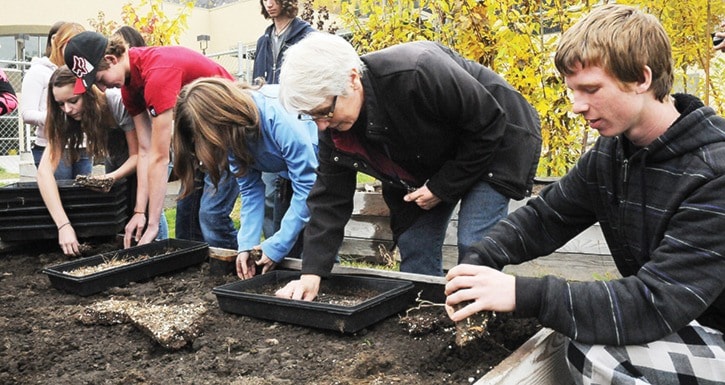A little blue flower holds the seed to historical West Kootenay culture that has almost disappeared from the natural landscape.
As part of a native plant restoration initiative called the Kootenay Camas Project, BC First Nations students dug into dirt this week to grow the Camassia quamash (camas), a plant with roots that once were a dietary staple for many indigenous people.
The Grade 12 students at J.L. Crowe Secondary, were given 50 seeds and bulbs in various stages of germination to sow in the high school’s garden, allowing them to monitor stages of growth during the next year.
The plant can take upwards of four years to mature from seed to flower, at which time the bulbs can be harvested and used as a food source.
Local botanist Valerie Huff, member of the non-profit Kootenay Native Plant Society, provided the camas seeds and bulbs cultivated from her Trail garden, and held the students’ attention with discussion of the plant’s origin and threats to its natural habitat.
The Camas Project sprouted from a chance encounter Huff had in the ‘80s when she first spotted the flower growing wild by the side of a South Slocan road.
“This flower had me pulling over to the side of the road because it was something I had never seen before,” she said.
“After research I learned it was camas and found that it was a major food crop for First Nations throughout the Columbia plateau.”
Through time, the once flourishing plant, which is a low-elevation species, was crowded out by the planting of lawns and greenery non-indigenous to the area.
“Camas goes hand in hand with people,” said Huff. “It likes to grow where we like to live, which is valley bottom and beside rivers. And lawns are their biggest enemy.”
The plant can be seen in limited clusters from the Gyro Park walkway in early spring, but only for a short time, explained Huff.
“They are a ‘now you see it, now you don’t,’” she said. “It only blooms for two or three weeks and then dies back and by the middle of June, it is gone.”
Besides students, the Kootenay Camas Project enlists the help from “citizen science,” which engages the public to observe, collect and record data about local camas populations.
“This is our second year highlighting camas,” said Huff. “Last year we asked people to report it but I was a bit skeptical that they would recognize it,” she continued. “But we didn’t get a single report of the wrong plant identified. Once you know what your are looking for, you can spot it.”
